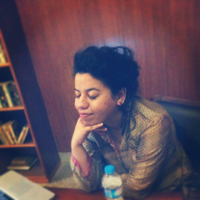More about The Dinner Party
- All
- Info
- Shop

Contributor
Some would say The Dinner Party is quite a spread.
Basically, Judy Chicago was all like, yeah…here’s a bunch of women who history doesn’t give enough props to, so I’m gonna put their vulvas on a table and call it a dinner party. How fun!
This giant (48’ x 48’ x 48’ ) equilateral triangle stresses equality through its proportions, aside from just being an essentially female symbol when pointing downwards (thanks, Dan Brown!). Thirty-nine lucky ladies have their own place settings at this party, along with another 999 whose names are inscribed onto the floor tiles. Chicago positioned 13 women on each arm of the triangle and these groups of thirteen allude to the number of people present at The Last Supper, which was a stags-only party as history states. So that’s her flipping off his-tory.
Each woman’s identity has been realized in this vulvic array by means of pattern and material, for example: frilly pink lace for Emily Dickinson, Egyptian hieroglyphics for Hatshepsut, fleur-de-lis for Eleanor of Aquitaine, etc. Critics since have had some things to say about the vag motifs, composed of varying mutations of butterflies and flowers. A lot of them weren’t down with the whole “imagine the vagina as stuff in nature” idea, and this included Georgia O’Keeffe. She was one of the guests who had privates dedicated to her, despite her insisting that her work has nothing to do with gender or sex.
The whole project cost more than a whopping $250,000 to complete, along with a bunch of hired help that included ceramicists, needlework experts, etc. These helpers were none to happy when Chicago declined to give them credit.
Featured Content
Here is what Wikipedia says about The Dinner Party
The Dinner Party is an installation artwork by American feminist artist Judy Chicago. There are 39 elaborate place settings on a triangular table for 39 mythical and historical famous women. Sacajawea, Sojourner Truth, Eleanor of Aquitaine, Empress Theodora of Byzantium, Virginia Woolf, Susan B. Anthony, and Georgia O'Keeffe are among the symbolic guests.
Each place setting includes a hand-painted china plate, ceramic cutlery and chalice, and a napkin with an embroidered gold edge. Each plate, except the ones corresponding to Sojourner Truth and Ethel Smyth, depicts a brightly colored, elaborately styled vulvar form. The settings rest on intricately embroidered runners, executed in a variety of needlework styles and techniques. The table stands on The Heritage Floor, made up of more than 2,000 white luster-glazed triangular tiles, each inscribed in gold scripts with the name of one of 998 women and one man who have made a mark on history. (The man, Kresilas, was included by mistake, as he was thought to have been a woman called Cresilla.)
The Dinner Party was produced from 1974 to 1979 as a collaboration and first exhibited in 1979. Despite art world resistance, it toured to 16 venues in six countries on three continents to a viewing audience of 15 million. It was retired to storage from 1988 until 1996, as it was beginning to suffer from constant traveling. In 2007, it became a permanent exhibit in the Elizabeth A. Sackler Center for Feminist Art at the Brooklyn Museum, New York.
Check out the full Wikipedia article about The Dinner Party




















